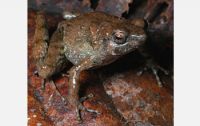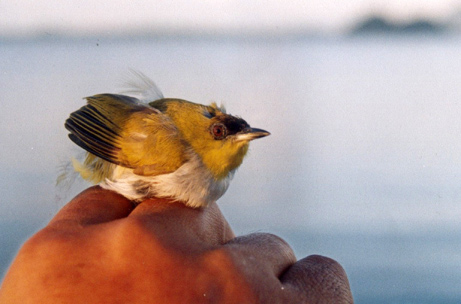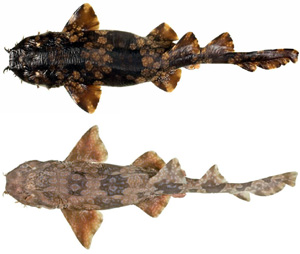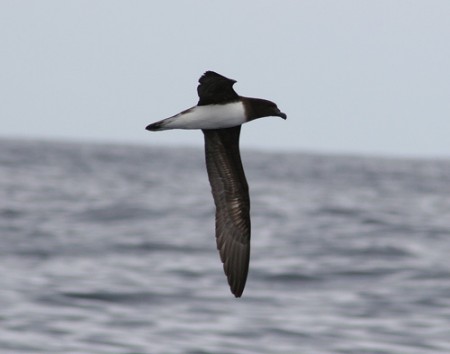New Species Photo Roundup
Posted by: Loren Coleman on March 20th, 2008
During the first couple weeks of March, several new species have been revealed as new discoveries. Here is a survey of their published images and links to more details about the findings.

The green tree skink (Prasinohaema virens) is one of five described species of green-blooded lizards from New Guinea. Credit: Chris Austin, Louisiana State University.

A new species of frog of the genus Hylophorbus from New Guinea. Credit: Chris Austin, Louisiana State University.

New species of catfish, Eutropiichthys britzi, is 166mm in length and is named after Museum scientist Ralf Britz. The fish comes from Myanmar in Southeast Asia. Credit: T. Britt Griswold/National Museum of Natural History, Smithsonian Institution.
Source: “Catfish named after Museum scientist”

Two field scientists from the University of Indonesia have found a new bird species, Zosterops Somadikartai or Togian white-eye, in the Togian Islands, Gulf of Tomini, Central Sulawesi province.

Photograph courtesy Mochamad Indrawan.
Sources: “New bird species found in Indonesia”; “New Bird Found in Indonesia”

Images of the floral banded wobbegong (top) and Dwarf spotted wobbegong. Courtesy of DoF.
Source: “Two shark species discovered”

A bird species not seen for 80 years has been rediscovered near Papua New Guinea. The Beck’s petrel (Pseudobulweria becki), long thought to be extinct, was photographed last summer by an Israeli ornithologist in the Bismarck Archipelago, a group of islands northeast of New Guinea.
Source: “Bird unseen for 80 years found”
And how about a dramatic 5th anniversary discovery’s photograph?
A new species of jellyfish, Big Red, Tiburonia granrojo, was discovered in 2003 by researchers from MBARI and from the Japanese Marine Science and Technology Center. This amazing jelly gets up to 1 meter in diameter and is found throughout the Pacific Ocean.
Source: “New Jellyfish Species Found”
About Loren Coleman
Loren Coleman is one of the world’s leading cryptozoologists, some say “the” leading living cryptozoologist. Certainly, he is acknowledged as the current living American researcher and writer who has most popularized cryptozoology in the late 20th and early 21st centuries.
Starting his fieldwork and investigations in 1960, after traveling and trekking extensively in pursuit of cryptozoological mysteries, Coleman began writing to share his experiences in 1969. An honorary member of Ivan T. Sanderson’s Society for the Investigation of the Unexplained in the 1970s, Coleman has been bestowed with similar honorary memberships of the North Idaho College Cryptozoology Club in 1983, and in subsequent years, that of the British Columbia Scientific Cryptozoology Club, CryptoSafari International, and other international organizations. He was also a Life Member and Benefactor of the International Society of Cryptozoology (now-defunct).
Loren Coleman’s daily blog, as a member of the Cryptomundo Team, served as an ongoing avenue of communication for the ever-growing body of cryptozoo news from 2005 through 2013. He returned as an infrequent contributor beginning Halloween week of 2015.
Coleman is the founder in 2003, and current director of the International Cryptozoology Museum in Portland, Maine.










Green-blooded lizards? Escaped pets from a secret Vulcan expedition?
😉
Two things that struck me.
1) When a bird – a flying bird, and not a rainforest bird, a seabird – goes unseen for 80 years, with ornithologists all over the world looking at, and for, such birds, well, it should tell us something.
2) Five years after discovery, how do they know that jellyfish is found “throughout the Pacific Ocean”?
“1) When a bird – a flying bird, and not a rainforest bird, a seabird – goes unseen for 80 years, with ornithologists all over the world looking at, and for, such birds, well, it should tell us something.”
Not really, considering a lot of seabirds spend most of their lives out at sea…
Blue Mako:
When we know it has been extinct, for what, 80 years, we have it down that exactly? We know enough about it to make it, well, doesn’t it seem to be a news story that somebody saw it again? I didn’t make that a news story.
Like I said: that should tell us something.
But what should it tell us? I think the majority of scientists are pretty open to the idea of rediscovered species, especially things like sea birds or small reptiles.
[sigh]
Science’s problem has always been what it’s NOT open to.
Here’s the lesson, spelt plain:
If you want to find them…
…you need to LOOK.
The situation with Beck’s Petrel is not really that surprising, but it is interesting. Olejason is correct to say that scientists tend to be quite open minded about the survival of a species despite it not having been seen for generations. Let’s not forget that the Thylacine is still only listed as “possibly extinct” by CITES (The Convention of International Trade in Endangered Species of Wild Fauna and Flora).
The fact is that the world is a very big place, and the vast majority of it is sparsely inhabited (by humans) and inaccessible. There are never going to be enough observers to categorically confirm the extinction or survival of most species. It’s actually nothing more than a stroke of luck that this ornithologist happened to be where he or she was when the Beck’s Petrel made a chance appearence. Had this been an entomologist or botanist, for example, the sighting may not have happened. Having said that, just because the bird hadn’t been seen for 80 years doesn’t mean that there was actually anybody looking for it.
nick_:
Good post, and it illustrates my point.
Which is: scientists should keep an open mind about the existence of ANY animal for which the evidence sounds plausible, regardless whether or not it’s been previously confirmed.
Not to get started what may actually be another thread (idea!). But your statement “the world is a very big place, and the vast majority of it is sparsely inhabited (by humans) and inaccessible” would be equally true if “the world” were replaced by “North America.” Or, really, any continent. People have a tendency to think, we’re everywhere! and everything’s been found! Beck’s Petrel is only one species for which the counter runs: not even close. It was known to exist; a substantial amount must have been known about it for its extinction to be considered likely (although maybe not, which makes that pronouncement suspect in the extreme); and just as likely, no one WAS (specifically) looking for it. Although I’m sure any ornithologist in its range had it in mind, or we probably wouldn’t have this news, or that clear photo.
The saola is, in absolute terms, a big animal; and it lives in a place that’s been ripped by war and, supposedly, ridden with people for the better part of a century. Yet it eluded science until 1992; and it had buddy species that eluded science in that very area even longer. There just hadn’t been a scientific expedition in that area looking, quite specifically, for new animals in almost all that time (and in almost all the time before). The animals we find tend generally to be the ones that find us; that’s only recently started to change.
The reason cryptozoology stays cryptic is that scientists have an unseemly tendency to invoke the General Implausibility Theorem (GIT) and make pronouncements they probably should think twice about making. Maybe the “declared extinct” pronouncement is one that scientists should simply stop using. For the very reasons stated in posts above, it was a very premature pronouncement on Beck’s Petrel, eh? And on numerous other species that I don’t need to list because others here could probably make a better list.
I have no problem with statements like “none confirmed [note: not “seen”] in 80 years” or “we haven’t seen conclusive proof, or compelling evidence, but what we have seen is intriguing.” Those are the kinds of statements scientists should make. They reflect the known state of affairs. If science is today’s arbiter of reality, it should stick, in its pronouncements, to what is known. Positive speculation (“the yeti is plausible”) is fine; science is supposed to expand what we know, not sit on it. But negative pronouncements stymie science by drying up the lifeblood of its advancement (i.e., money).
“Not sure, but could be” works. “There aren’t any” or “that doesn’t exist”? Not so much.
It’s too bad that most of these species have been discovered just as they are on the cusp of extinction. Let’s hope we have enough time to officially declare them as endangered species and protect them before they disappear.
Thanks for this useful post, Loren. As I was saying in another post, it is these findings of new macrofauna (all the time, and in some quite unexpected locations) that allows the subject of Cryptozoology to retain some degree of credibility and focus, in the light of the bizarre theories and obvious hoaxes being put out by some marginal elements, who seem obsessed with releasing fake bigfoot / sasquatch / yeti / mermaid / lochness etc stories, images and (worst yet) videos.
It’s always encouraging when new macrofaunal species is discovered, since I have a particular interest (personal & professional) in reptiles/amphibians (i.e. herpetofauna), fish (i.e. ichthyofauna) and birds (i.e. avifauna) and at least (so far) it has not become profitable for people to claim fake discoveries in these fields. As long as these discoveries are made, the subject in its entirety will continue to be relevant and credible !!!
In response to the various comments above on the “re-discovery of the Becks Petrel” after 80 yr:
The fact is that many species of migratory shorebirds and seabirds are remarkably similar to each other, to the point that it would be exceedingly difficult for the average observer to tell them apart. In many cases, species identification relies on very fine distinctions in markings or plumage (which themselves tend to show seasonal variation) or otherwise through through extremely subtle differences in physical behaviour (movement, hunting, vocalisation, head-bobbing, etc). A photograph would always be helpful, but especially in the case of seabirds observed from boats, such images (of sufficient quality for diagnostic purposes) are usually difficult to capture. Dead specimens washing up on beaches are often too decomposed to be useful in determining whether they are something unusual.
As alluded to by nick_beyondthetree, the majority of observers (especially of birds typically seen far out to sea) would be perfectly unaware that they were seeing something rare or reputedly extinct. So it is probably a little misleading to say that the Beck’s Petrel was “not seen for 80 yrs”…It may very well have been seen by many, who were unaware of its significance. I agree with DWA that “not confirmed” is really a better way of saying it.
But once again, such is the typical arrogance of many mainstream scientists. Notwithstanding that, the fact they’re willing to admit “OK, we were wrong, it’s not really extinct” is a bonus for the aims, objectives and intentions of Cryptozoology. Unless there are consistent rumours of something being non-extinct (like Thylacine) why would anybody be looking for it in the first place? Nobody is out looking for the Dodo (I think).